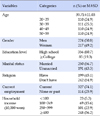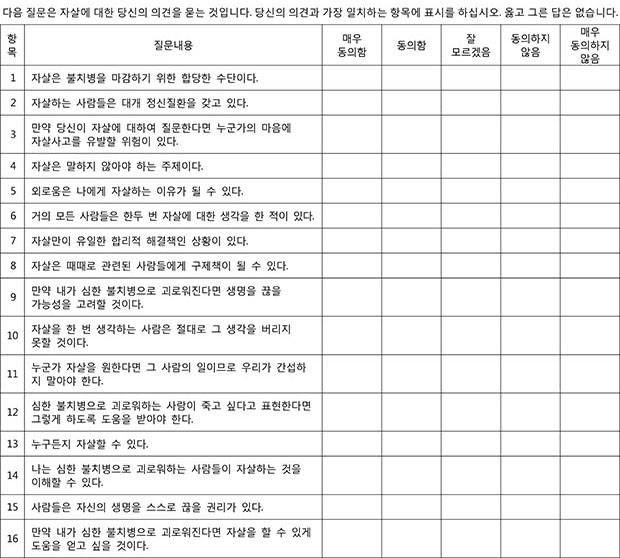2. Korea Suicide Prevention Center. 2019 White Book. Annual Report. Seoul: Ministry of Health & Welfare (KR);2019. 05. Report No. ISSN 2508-2485.
3. Hedman LC, Petrila J, Fisher WH, Swanson JW, Dingman DA, Burris S. State laws on emergency holds for mental health stabilization. Psychiatric Services. 2016; 67(5):529–535. DOI:
10.1176/appi.ps.201500205.

5. Kim SW, Kim SY, Kim JM, Suh TW, Shin IS, Kim SJ, et al. A survey on attitudes toward suicide and suicidal behavior in Korea. Journal of the Korean Society of Biological Therapies in Psychiatry. 2008; 14(1):43–48.
6. Renberg ES, Jacobsson L. Development of a questionnaire on Attitudes Towards Suicide (ATTS) and its application in a Swedish population. Suicide and Life-Threatening Behavior. 2003; 33(1):52–64. DOI:
10.1521/suli.33.1.52.22784.

7. McAuliffe C, Corcoran P, Keeley HS, Perry IJ. Risk of suicide ideation associated with problem-solving ability and attitudes toward suicidal behavior in university students. Crisis: The Journal of Crisis Intervention and Suicide Prevention. 2003; 24(4):160–167. DOI:
10.1027/0227-5910.24.4.160.

8. Ji NJ, Hong YP, Lee WY. Comprehensive psychometric examination of the Attitudes Towards Suicide (ATTS) in South Korea. International Journal of Mental Health Systems. 2016; 10(2):1–6. DOI:
10.1186/s13033-016-0035-0.

9. Domino G, Takahashi Y. Attitudes toward suicide in Japanese and American medical students. Suicide and Life Threatening Behavior. 1991; 21(4):345–359.
10. Poreddi V, Thimmaiah R, Ramu R, Selvi S, Gandhi S, Math SB. Gender differences related to attitudes toward suicide and suicidal behavior. Community Mental Health Journal. 2016; 52(2):228–232. DOI:
10.1007/s10597-015-9913-1.

11. Siau CS, Wee LH, Ibrahim N, Visvalingam U, Wahab S. Crosscultural adaptation and validation of the attitudes toward suicide questionnaire among healthcare personnel in Malaysia. Inquiry: A Journal of Health Care Organization, Provision, and Financing. 2017; 54:1–9. DOI:
10.1177/0046958017707295.

12. Domino G, Gibson L, Poling S, Westlake L. Students' attitudes toward suicide. Social Psychiatry. 1980; 15(3):127–130.
13. Ban YJ, Park YM, Suk JH. A preliminary study on the attitude toward suicides in normal persons. Journal of Korean Neuropsychiatric Association. 1989; 28(1):155–167.
14. Möller HJ, Schmidtke A, Welz R, editors. Attitudes toward suicide: development of a Suicide Attitude Questionnaire (SUIATT). Berlin, Heidelberg: Springer;1988. p. 476.
15. Ware Jr JE, Sherbourne CD. The MOS 36-item short-form health survey (SF-36): conceptual framework and item selection. Medical Care. 1992; 30(6):473–483.
16. Kodaka M, Poštuvan V, Inagaki M, Yamada M. A systematic review of scales that measure attitudes toward suicide. International Journal of Social Psychiatry. 2011; 57(4):338–361. DOI:
10.1177/0020764009357399.

17. Segal DL, Mincic MS, Coolidge FL, O'riley A. Attitudes toward suicide and suicidal risk among younger and older persons. Death Studies. 2004; 28(7):671–678. DOI:
10.1080/07481180490476524.

18. Park JI, Kim YJ. Factor structure of Korean version of Attitudes Toward Suicide (ATTS-20). Mental Health and Social Work. 2014; 42(1):92–114.
19. Mitchell RJ. Design and analysis of ecological experiments. Oxford, UK: Oxford University Press;2001. p. 432.
20. Ahn YM, Park JI, Gi SH, Kim KI, Kim BR, Lee SU, et al. 2013 national survey on suicide. Ministry of Health and Welfare Research Project Report. Seoul: Korea Suicide Prevention Center;2014. 03.
21. Dilorio CK. Measurement in health behavior: methods for research and education. 1st ed. San Francisco, CA: Jossey-Bass;2005. p. 336.
22. DeVellis RF. Scale development: theory and applications. 4th ed. Thousand Oaks, CA: Sage Publications;2016. p. 280.
23. Polit DF, Beck CT. The content validity index: are you sure you know what's being reported? Critique and recommendations. Research in Nursing and Health. 2006; 29(5):489–497. DOI:
10.1002/nur.20147.

24. Lee SJ, Moon SM, Lee JM, Yon KJ. The moderating effects of permissive attitude toward suicide and experience of suicide loss on the relationship between depression and suicidality. Korean Journal of Counseling. 2015; 16(4):23–43. DOI:
10.15703/kjc.16.4.201508.23.

25. Kim YH, Sim KN, Yoo JA, Kim SH, Kim M, Kim YA, et al. Comparison of attitudes towards five end-of-life care interventions (active pain control, withdrawal of futile life-sustaining treatment, passive euthanasia, active euthanasia and physician-assisted suicide): a multicentred cross-sectional survey of Korean patients with cancer, their family caregivers, physicians and the general Korean population. BMJ Open. 2018; 8(9):e020519. DOI:
10.1136/bmjopen-2017-020519.

26. Gielen J, van den Branden S, Broeckaert B. Attitudes of European physicians toward euthanasia and physician-assisted suicide: a review of the recent literature. Journal of Palliative Care. 2008; 24(3):173–184. DOI:
10.1177/082585970802400307.

27. Emanuel EJ, Onwuteaka-Philipsen BD, Urwin JW, Cohen J. Attitudes and practices of euthanasia and physician-assisted suicide in the United States, Canada, and Europe. JAMA. 2016; 316(1):79–90. DOI:
10.1001/jama.2016.8499.

28. Lee JW. Ethical issues of suicide. The Society of Korean Christian Social Ethics. 2011; 21:103–132.
29. Lee EO, Lim NY, Park HE, Heo IS, Kim JY, Bae JE, et al. Nursing research & statistics. Paju: Soomoonsa;2009. p. 270.
30. Bae BR. Structural equation modeling with Amos 19: principles and practice. Seoul: Chungram Books;2011. p. 668.









 PDF
PDF ePub
ePub Citation
Citation Print
Print








 XML Download
XML Download